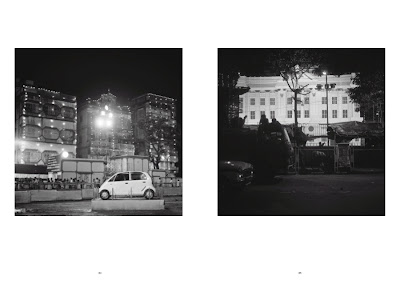Hackney Wick. By Stephen Gill. Nobody books, 2005. 126pp. with 24 page special section, illustrated throughout, 21,6x21,6 cm. Images from here.
Still in my heart... (stay safe and support
riot clean-up)
Book
description:
"Hackney Wick sits in east London between the Grand Union Canal, the River Lea and the Eastway A106. I first came across the area at the end of 2002 when I was photographing the back of advertising billboards. Although I had lived in London for nine years and thought I knew East London well, Hackney Wick threw me; it completely changed my mental map of this part of London.
My first visit was on a Sunday, to the market which used to take place in the old greyhound/speedway stadium. The vast market was like no other I had seen before. At first glance, apart from few pot plants, most of the items on sale looked like scrap. It was not a market for luxury goods; it seemed to exist for people who were struggling to keep afloat themselves: exhausted white goods, mountains of washing machines and fridges, copper wire and other scrap metals stripped from derelict buildings; piles of old VHS videos which had been forced out of people’s homes to make way for DVDs.
That day I bought a plastic camera at the market for 50p; it had a plastic lens with no focus or exposure controls. I started making pictures with it at once.
Over the next two years I visited Hackney Wick again and again. Hackney has long provided a refuge for immigrants and asylum seekers from all over the world and for me Hackney Wick especially reflects the great diversity of London.
The market closed on 13th July, 2003; it had been going for seven years. According to the Trading Standards inspectors it had been swamped with stolen and counterfeit goods. The remains of the old stadium were demolished weeks after the closure as part of the preparations for London’s bid for the 2012 games. The games which will bring many good things to the area: new transport links and much needed infrastructure. But there will be losses, too.
There is another side to Hackney Wick. Away from the noise and chaos nature has somehow managed to find and keep a place for itself. The canals and rivers and secret allotments (known only to their dedicated gardeners) are home to many birds and animals. These hidden paradises have a vibrancy of their own which will soon be muted by the dust that will cover them."
I really like the work of
Stephen Gill and have featured it previously
here,
here,
here,
here,
here and
here. I especially like his thoughts on the book as an integrated part of his photography work:
"His overriding intention is to make the book the finished expression of the photographs, rather than just a shell in which to house them.
Experimentation with materials, and a hands-on, tactile approach to maquette making lead, in many cases, to his finished books having an individual, unique presence.
This tactile approach includes materials and techniques such as lino cut printing, letter press printing, mono prints, spray paint, rubber stamps and on occasion entire books are manufactured and assembled by hand in Stephen’s Hackney studio.
He considers the bookmaking process to be a key final stage in the production of his photographic works, and he aims to make books that are conceptually consistent with their content."
(source for quote)









































